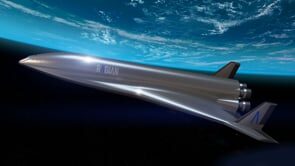Radian Aerospace, a Seattle-area startup, is actively working on the design and development of its orbital space plane, with plans to build a subscale prototype as early as this year. The company has recently secured $27.5 million in investment and is currently in the process of raising more funding to support its ambitious space plane project. The ultimate goal of Radian is to create a reusable winged space plane that can be launched towards low Earth orbit through a rocket-propelled sled and its own rocket engines, a concept known as single-stage-to-orbit (SSTO) that could revolutionize cheap access to space.
Livingston Holder, co-founder and chief technology officer of Radian Aerospace, has extensive experience in the aerospace industry, having previously worked on an SSTO project for NASA called the X-33. With advancements in materials and technology, Holder is optimistic about the progress being made on the Radian One space plane. The vehicle is being designed using carbon matrix composites and a thermal protection system that is currently undergoing testing in collaboration with NASA’s Glenn Research Center in Ohio. Radian One is designed to accommodate up to five crew members and carry significant payload to and from low Earth orbit.
Radian Aerospace recently partnered with NASA Glenn to conduct high-temperature tests on its Thermal Protection System Engineering Development Unit. The propulsion system for Radian One has been modified to use methane and liquid oxygen as propellants, with plans for five powerful rocket engines on the space plane. The company is also working on developing additional rocket engines for the sled launcher, which will provide an initial push lasting about 20 seconds. Testing for the rocket engines has been conducted in Bremerton, Washington, and other parts of the Pacific Northwest.
While technically based in Renton, Washington, Radian Aerospace has a distributed workforce with about two dozen employees. The company is looking to expand its operations in the Seattle area once the next fundraising round is completed. Holder hinted at plans to unveil a prototype of the space plane later this year, which will offer insights into the vehicle’s flight characteristics. The long-term goal for Radian is to conduct the first flight of the full-scale Radian One by 2030, aligning with NASA’s transition to new commercial space stations.
Radian One is envisioned to play a role in Defense Department missions, as well as support on-demand launch capabilities, flexible landing options, and quick mission turnaround times. Holder believes that Radian Aerospace can carve out a niche in the orbital transport market, despite competition from larger companies like SpaceX, Boeing, and Lockheed Martin. He likens the future space transportation ecosystem to terrestrial transportation systems, where each component has a specific role to play. Radian Aerospace aims to provide a smaller but essential service within the broader orbital infrastructure.
The potential applications for Radian One span beyond commercial space stations to include military missions and disaster response scenarios, where quick and efficient access to space is crucial. Holder is confident in Radian’s ability to deliver a unique service in the future space transportation architecture, emphasizing the need for a diverse range of capabilities in the industry. As the company continues to refine its design and secure funding for further development, Radian Aerospace is poised to make significant advancements in the field of orbital transport technology.


